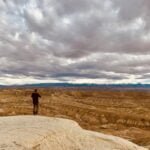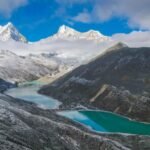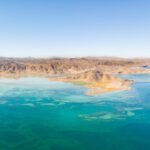In the remote corners of Ritu County, Ngari, a treasure trove of ancient art awaits discovery. Nestled within an area of 200 to 300 square kilometres near Pangong Lake, these mesmerizing rock paintings are a testament to the rich history and culture of this region. Carved onto the rugged rock walls, these artworks are not only numerous but also of exceptional artistic value. In this article, we will take you on a journey through the enigmatic world of Ritu Rock Paintings, shedding light on their history, significance, and unique features.
Xiaqulong Rock Paintings: A Glimpse into the Ancient Plateau
Location and Features
The Xiaqulong rock paintings, located southwest of Xiaqulong Village in Ritu County, offer a fascinating glimpse into the ancient plateau’s social life. Situated at an altitude of 4,350 meters, these paintings are divided into two groups, separated by 400 meters. The first group comprises four images, including a square image with vertical intersecting diagonal lines and two “swastika” symbols alongside an animal figure. The second group features nine images, showcasing mounted hunters with crossbows and various animals like yaks, deer, and donkeys.
Historical Significance
Dating back to the Early Metal Period in Tibet, these rock paintings are not only artistic but also hold historical significance. The knock-out pit technique used in these paintings adds a unique touch to their creation. Notably, the presence of the “swastika” symbol, an ancient motif associated with auspiciousness and eternity, reflects the rich cultural heritage of the region.
Ruzhilangka Rock Paintings: A Canvas of Ancient Life
Location and Content
Situated approximately 10 miles west of Ritu County, the Ruzhilangka rock paintings are perched at an altitude of 4,270 meters. These open-air cliff rock paintings, ranging from 1 to 20 meters in height, offer a diverse range of subjects. The paintings include depictions of animals such as tigers, deer, and yaks, as well as scenes of hunters, warriors, shepherds, and animal-headed gods. Weapons like bows and arrows, spears, crossbows, knives, and swords are also prominently featured, along with natural elements like the sun, moon, and various plants.
Themes and Period
The paintings are categorized into four themes: hunting, herding, war, and animals. Notably, the hunting-themed images provide insights into the hunting methods of the time, including hunting on foot and horseback. The use of hounds and falcons in the hunt, as well as the depiction of trap-setting, showcases the resourcefulness of the ancient people. The rock paintings employ a simple and random composition style and belong to the early metal age before the Tubo period.
Alonggou Rock Paintings: A Tale of Hunting and Warfare
Location and Subjects
Nestled on the south side of the Ritu District residence at an altitude of 4,370 meters, the Alonggou rock paintings are a testament to the region’s hunting and warfare history. These paintings predominantly feature animals like yaks, water birds, sheep, deer, and dogs. Characters depicted include hunters, herders, and warriors, often engaged in various activities. The vivid and lifelike compositions are a testament to the artists’ skills.
Themes and Timeframe
The paintings are divided into two main themes: hunting and warfare. Notably, the hunting scenes illustrate both foot and horseback hunting techniques, with images of horse-riding hunters chasing wild yaks with crossbows. The depiction of warriors in battle, wearing robes and armed with shields and crossbows, provides valuable insights into the region’s history. These paintings also belong to the early metal age before the Tubo period.
Nabulong Petroglyphs: A Glimpse of Ancient Hunting
Location and Techniques
Located in the valley on the north bank of Pangong Lake in Ritu County, the Nabulong rock paintings stand at an altitude of 4,800 meters. These open-air cliff paintings employ tapping and carving techniques to create deep impressions of 1 mm to 4 mm. Sharp tools are used to outline the images, with some showing entire bodies hammered within the outlines, creating a “silhouette” effect.
Themes and Imagery
The main theme of the Nabulong rock paintings is hunting and hunting-related wild animals. The nearly 40 individual images include yaks, sheep, deer, donkeys, hunters, and even depictions of gods. Notably, the antlers of the depicted animals are intricately detailed, with semicircles and symmetrical branches adding a decorative element to the images.
Takangba Petroglyphs
Venture southeast of Nabulong Rock Paintings, and you’ll stumble upon the enigmatic Takangba Rock Paintings. Nestled 4720 meters above sea level, these striking images paint a vivid picture. Carved into the rock faces, more than 10 groups of petroglyphs capture scenes of daily life, with hunting and nature worship as recurring motifs. Artists employ both knocking and chiselling methods, accentuating the textural depth of these ancient masterpieces.
Display Rock Paintings
Journey to the western reaches of Zabu Township in Ritu County, and you’ll discover the intriguing Buxian Rock Paintings. Perched at 4420 meters above sea level, these rock paintings adorn the mountain’s base, their artistry speaking of a time long past. Carved into the rock surfaces, they employ a “silhouette” technique, chiselling out images of animals, yaks, and sheep. The stark simplicity of these images is a testament to the artistic sensibilities of a bygone age.
Kangba Rejiu Rock Paintings
Emerge eastward from Zabu Township in Ritu County, and you’ll encounter the Kangba Rejiu Rock Paintings. At an altitude of 4620 meters, these open-air cliff rock paintings narrate scenes of hunting and warfare. Images of hunters, herders, and warriors come to life, each etching a story in stone. Animal figures, including yaks, water birds, and sheep, mingle with the characters in these captivating tales. The simplicity and casual style of these paintings take us back to the early metal age.
Lubu Lake Rock Paintings
Located on the northeastern shore of Lubu Lake, Rebang District, these rock paintings occupy an altitude of 4360 meters. A rich tapestry of motifs, they delve into hunting, herding, and battle scenes. The canvases brim with animals such as yaks, horses, dogs, sheep, and deer. With their simple and realistic style, they offer a glimpse into life during the early metal age.
Zuoyong Lake Rock Paintings
Move west of Rebang District in Ritu County, and you’ll stumble upon the beguiling Zuoyong Lake Rock Paintings. Nestled at an altitude of 4430 meters, these open-air cliff paintings beckon curious observers. Images of yaks, deer, and shepherds take centre stage, while the “swastika” symbol adds a layer of symbolism to the narrative. The starry sky style of herding is a recurring theme, capturing the essence of life in a distant age.
Guoba Rock Paintings
In the vicinity of Risong District in Ritu County, the Guoba Rock Paintings beckon those seeking ancient artistry. These open-air cliff paintings are located at an altitude of 4420 meters. The artists employ a range of techniques, including knocking and carving methods, to create their masterpieces. The paintings predominantly feature animals, including yaks, sheep, horses, and deer, alongside hunting scenes. The unique artistry of these paintings brings us face-to-face with the early metal age.
Rimudong Rock Paintings
Southeast of Risong District, you’ll uncover the Rimudong Rock Paintings. These open-air cliff paintings are etched on the joint surfaces of bedrock at the foot of the mountain. The artistry is breathtaking, with distinctive knocking and chiselling methods employed to narrate stories. The motifs encompass animals, people, natural objects, hunting scenes, and more. Here, the early metal age comes alive through a tapestry of images that tell the tale of the past.
Niangma Rock Paintings
To the east of Risong District, venture toward Niangma, where rock paintings perch at an altitude of 4380 meters. These open-air cliff paintings exude an air of mystique. They employ intricate knocking and chiselling techniques to create masterpieces that portray a multitude of elements. The artistry includes animals, people, hunting scenes, and the starry sky herding style. These enigmatic images carry the legacy of the early metal age.
Qumei Rock Paintings
East of Niangma, you’ll find the Qumei Rock Paintings. These open-air cliff paintings, perched at 4560 meters above sea level, stand as a testament to ancient artistry. Artists have used both knocking and chiselling techniques to narrate tales of herding, hunting, and natural motifs. Animals, people, and the vast sky intertwine in these captivating compositions, offering a glimpse into the past.
Lala Rock Paintings
Located in the north of Risong District in Ritu County, the Lala Rock Paintings are nestled at an altitude of 4650 meters. These open-air cliff paintings employ intricate knocking and chiselling techniques to bring to life an array of scenes. From hunting and herding to animals and people, the tapestry of motifs is a portal to the early metal age.
Bangong Lake Rock Paintings
The final chapter in this journey of rock artistry leads us to the enchanting Pangong Lake. Scattered along its shores are a plethora of rock paintings. These images weave intricate tales of the past. With motifs ranging from hunting and herding scenes to animals and celestial objects, these masterpieces illustrate life in the early metal age.
The Ritu rock paintings remain an enigmatic testament to the bygone era, offering insights into the lives and cultures of ancient plateau inhabitants. A visit to this exquisite treasure trove is akin to embarking on a journey back in time, where art, history, and nature harmoniously coexist. Plan your visit today, and let the Ritu rock paintings cast their spell, evoking a sense of wonder and reverence for this ancient artistry.


















